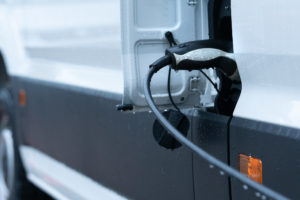Like any technological innovation, the electrification of mobility also must contend with bias, preconceptions and even downright myths. Whether industrialization, the development of mass-transit or the digital revolution: if we’d only listened to the critics and skeptics, we’d still be riding around in oxcarts and computing with slide-rules.
In the case of e-mobility, certain biases turn out to be myth with no base in fact. Other biases, formed in early e-mobility times, are outdated, and already solved through new technological advances.
It’s high time to put those persistent myths & biases about e-vehicles and e-fleets to bed. Time for a reality check. So here they are, the five biggest biases about e-fleets — and what the reality is.
Bias 1: The range of electric vehicles is far too low
Contrary to preconceptions, the range of electric vehicles is constantly increasing. Currently — depending on battery manufacture — ranges vary from 160 km to 650 km with a full battery charge. Range is also affected by factors such as driving style, temperature and weather conditions or equipment wear & tear. But this is no different to a combustion engine vehicle (ICE).
Here’s an interesting finding of particular interest to e-fleet operators: Initially assumed EV range requirements are often overestimated. This means that fleet vehicles are often back at the depot faster than estimated — some even with a charge left. That makes accurately calculating ranges for routes an essential and economical consideration.
This is one very good reason to do an in-depth fleet analysis at the beginning of your fleet’s EV transition. In any case, with the EV ranges of 2022, the chances of being stranded in the middle of nowhere are slim indeed. Range anxiety, adieu.
Bias 2: Charging is far too time-consuming
Like range anxiety, the bias about long charging times persists. If you believe the myths, EVs can’t drive very far, and they need to charge far too long. Again, how often do you see a desperate e-vehicle driver with an empty battery stranded in the middle of nowhere?
Charging times also depend on various factors like battery capacity, charging type, charging infrastructure, grid limits, actual demand and more. When converting a fleet to EVs, it’s important to carry out a realistic and data-based analysis of the demand and the necessary charging infrastructure requirements. That, by the way, is where PANION Transition and PANION Charging software comes in.
In the case of charging stations, a basic distinction is made between AC charging stations (alternating current) and DC charging stations (direct current):
- Alternating current (AC) is used to charge electric vehicles in private or residential areas, at wall-boxes and at normal 230V public charging points.
- Charging stations for electric cars that feed in direct current (DC) are called fast charging stations. With them, the alternating current (AC) is converted into direct current (DC) via a rectifier.
With DC charging, much higher charging performance can be achieved than the usual 22 kW for AC charging. However, since these fast-charging stations are associated with higher costs, they might only be interesting for long-haul highway-based transport. For the everyday life of most e-fleets, where vehicles often sit for at least 20 minutes, AC charging with alternating current is sufficient. More than likely, a combination of DC fast charging by day (on-demand), and slower AC charging by night will become the norm for commercial fleets.
How long the charging process of an e-vehicle at a charging station takes also depends on the performance of the charging station. For a battery with an output of 58 kWh and a charge of up to 80 percent, the charging speed at charging stations, wall-boxes and household sockets is between a few minutes and 10 hours. The higher the charging power, the faster the charging process is completed. With short charging stops, called “top-up” charging, for example, an additional range of 80–100km can be added quickly.
As of April 2022, a total of 48,225 public standard charging points and 8,401 fast charging points have been registered with the Federal Network Agency in Germany. It is important to know that many e-cars can easily find the nearest charging station on a map via their onboard computer. Additionally, the trend for fleets seems to point to companies installing their own depot charging stations.
Bias 3: Power grids are insufficient for e-mobility
Frauenhofer Institut calculated that on average only 30 percent of EVs are charged simultaneously. In most cases, charging occurs overnight. Overnight charging allows for more time to charge batteries than is generally needed.
For example; if all 45 million passenger cars in Germany were EVs, the demand for electricity would only increase by about 20 percent, to 100 terawatt hours (TWh) per year. Of course, it is important that the share of renewable energies increases to strengthen the grid and sustainability goals — which is not the real problem, because so far, we’re on the right track.
What really matters is controlling electricity demand for mobility with “intelligent” grids. That’s why network operators take recurring charging peaks into consideration and develop concepts to cover the needs of e-mobility in the long term. One thing is certain: With intelligent grids and smart charging stations, the electricity for e-mobility will be optimally distributed.
Bias 4: Electro-mobility? It’s way too expensive!
Currently, new vehicle purchase prices for EVs are higher than for ICEs. But if you take an overall view, an electric vehicle can be cheaper on balance. In the mid-term your total cost of ownership (TCO) will pay off considerably. State subsidies (which in Germany will be reformulated again from the end of 2022), tax breaks, operating costs and of course energy costs aim to incentivize EV purchase.
Here’s an example from Germany: The state subsidy will be €4,000 for the purchase of a fully electric vehicle (BEV) from 2023, and €3,000 for 2024 and 2025. In addition, no vehicle tax will be charged for newly registered EVs until the end of 2030.
Energy costs are also looking good: On average, an electric vehicle needs about 15 kWh of energy per 100km. With an average electricity price of 30 cents per kilowatt hour, this makes around €4.50. A gasoline engine, on the other hand, needs about 5.5 liters per 100 kilometers. This results in fuel costs of approximately €8.25. That’s around 50% less for powering an EV.
Overall, conducting a careful, data-based analysis, combined with a holistic consulting approach can draw a more precise picture of a successful and sustainable EV fleet transition.
Bias 5: An e-fleet will disrupt my operational business continuity
The interplay of cost-effectiveness, sustainability and efficiency not only works, but also optimizes operations and business continuity at scale. E-fleets, therefore, make a clear best-case scenario for both climate and business sustainability.
At PANION, our software employs a three-part model for fleet transition to provide transparent and independent decision-making tools with data-driven analysis. The three pillars of this model are fleet & infrastructure analysis (PANION Transition), charging operations optimization (PANION Charging) and holistic, customer success-oriented consulting. Carried out in advance, it results in a realistic picture of all areas and related tasks, as well as expected costs and budget compliances. And the entire process is transparent right from the start.
The preconception that transitioning to an e-fleet disrupts company operations is simply unfounded, if it’s done right. In addition to a considerable image gain in terms of climate sustainability, an e-fleet (and of course mixed fleets) can already be operated economically and efficiently — today!




